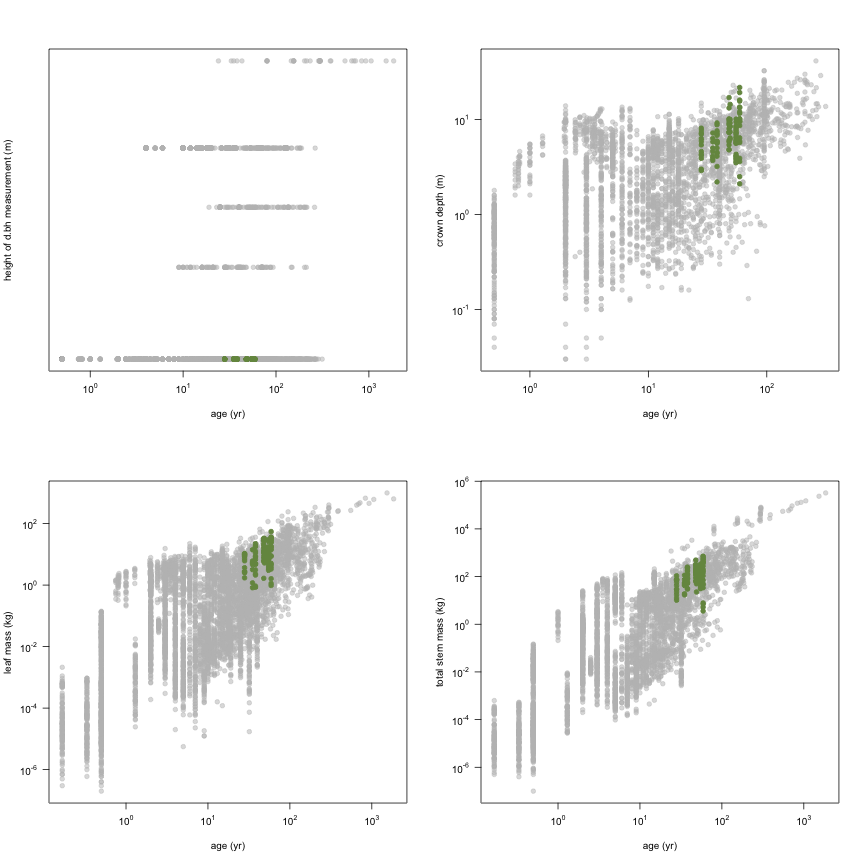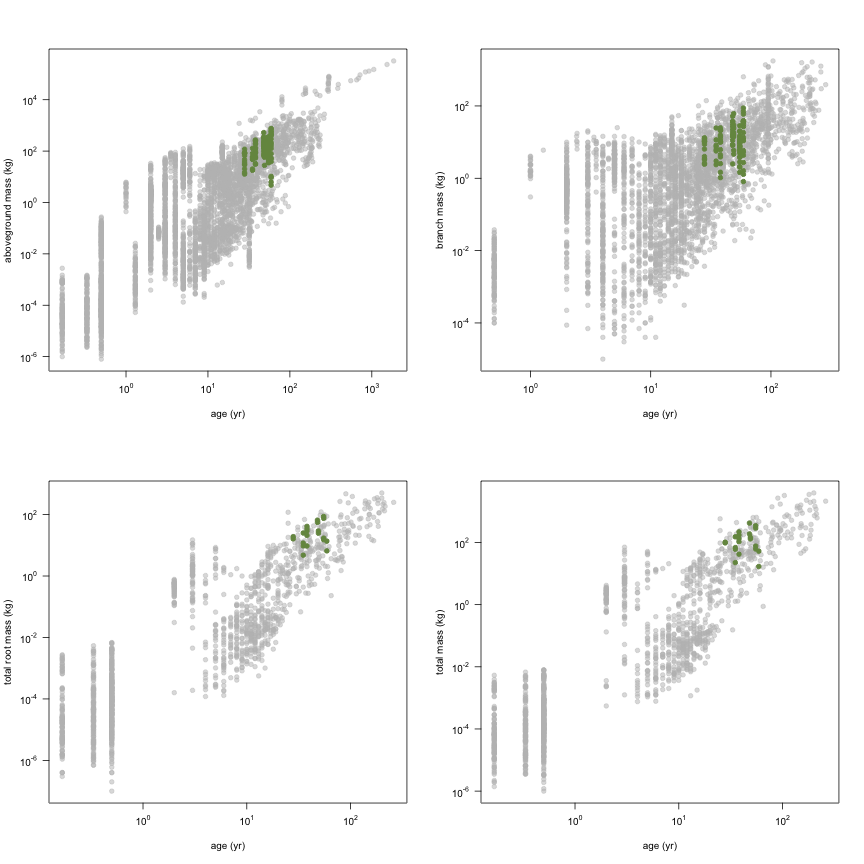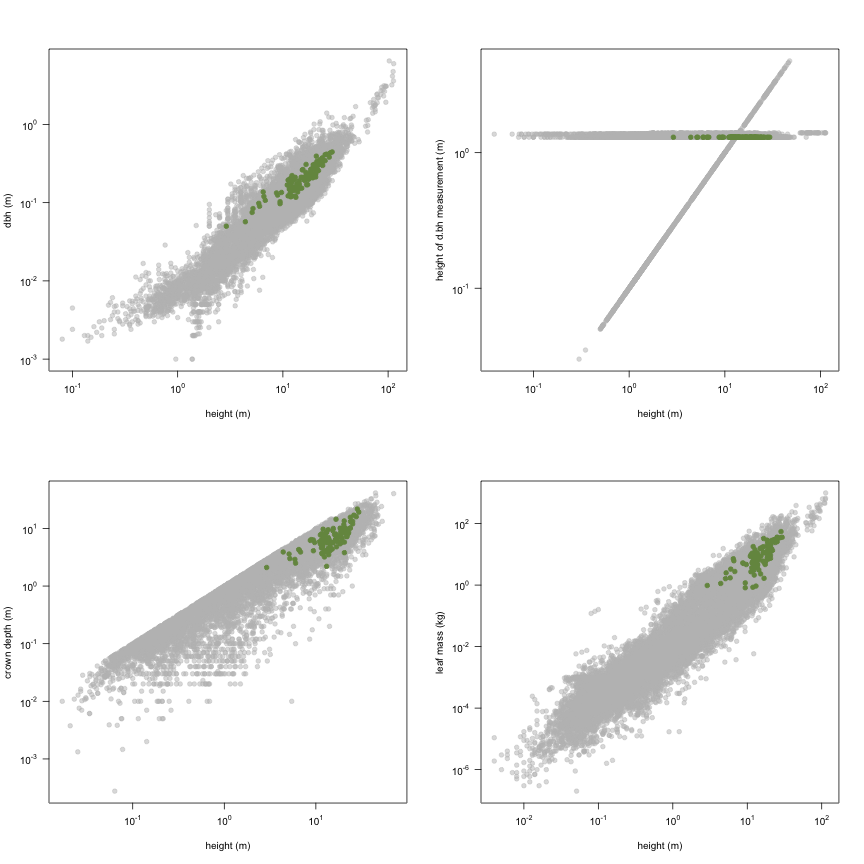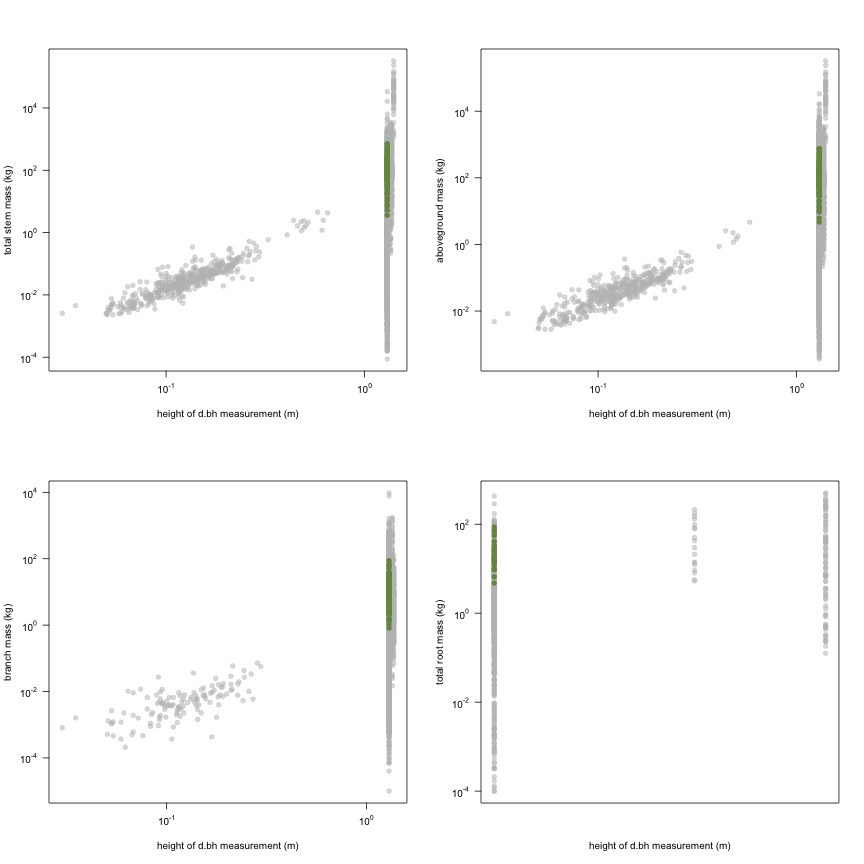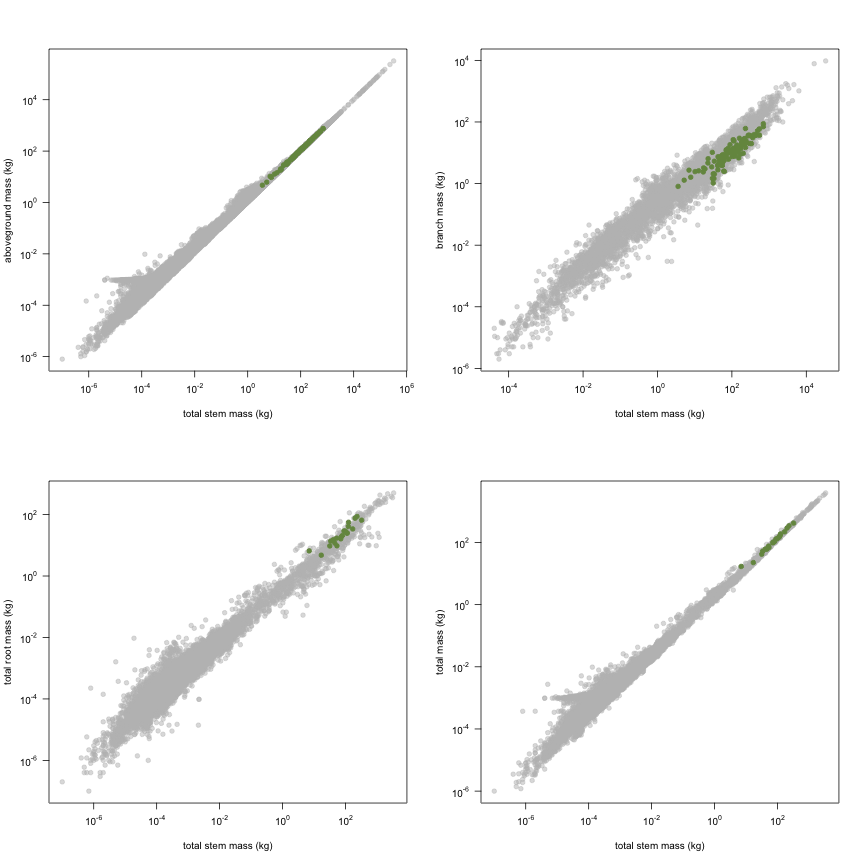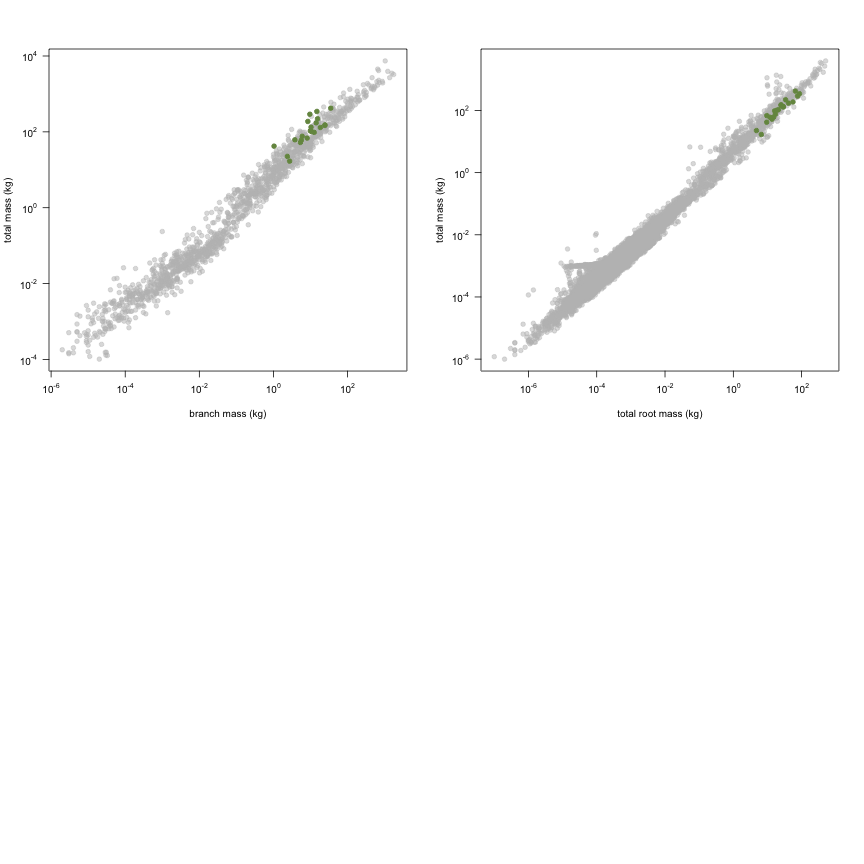-
Notifications
You must be signed in to change notification settings - Fork 19
Harada1972
Data contributor: Masae I. Ishihara, Hajime Utsugi, Hiroyuki Tanouchi, Tsutom Hiura
Email: [email protected]
Address:
- Graduate School for International Development and Cooperation, Hiroshima University, 1-5-1 Kagamiyama, Higashi-Hiroshima 739-8529, Japan
- Forestry and Forest Products Research Institute (FFPRI), 1 Matsunosato, Tsukuba, Ibaraki, 305-8687, Japan
- Hokkaido Research Center, Forestry and Forest Products Research Institute (FFPRI), Hitsujigaoka-7, Toyohira, Sapporo, Hokkaido, 062-8516, Japan
- Tomakomai Research Station, Field Science Center for Northern Biosphere, Hokkaido University, Takaoka, Tomakomai 053-0035, Japan
Citation: Harada H, Satoo H, Hotta I, Hatiya K and Tadaki Y (1972). 'Study on the nutrient contents of mature Cryptomeria forest.' Bulletin of the Government Forest Experiment Station, 249, pp. 17-74.
DOI:
Abstract:
The dataset includes records for 106 individuals from 1 species belonging to 1 family(ies), presenting 1 functional type(s), growing in 1 condition(s) within 1 major type(s) of habitat, with data included for the following variables:
| Variable | Label | Units | N | Min | Median | Max |
|---|---|---|---|---|---|---|
| latitude | Latitude | deg | 106 | 35 | 35 | 38 |
| longitude | Longitude | deg | 106 | 138 | 139 | 140 |
| age | Age | yr | 106 | 28 | 48 | 59 |
| a.stbh | Stem area at breast height | m2 | 106 | 0.002 | 0.031 | 0.16 |
| h.t | Height | m | 106 | 2.9 | 15 | 29 |
| h.c | Height to crown base | m | 106 | 0.5 | 8.6 | 17 |
| d.bh | Dbh | m | 106 | 0.05 | 0.2 | 0.45 |
| h.bh | Height of d.bh measurement | m | 106 | 1.3 | 1.3 | 1.3 |
| c.d | Crown depth | m | 106 | 2.1 | 6.5 | 22 |
| m.lf | Leaf mass | kg | 106 | 0.82 | 9 | 55 |
| m.st | Total stem mass | kg | 106 | 3.6 | 93 | 702 |
| m.so | Aboveground mass | kg | 106 | 4.7 | 102 | 755 |
| m.br | Branch mass | kg | 106 | 0.81 | 11 | 87 |
| m.rt | Total root mass | kg | 21 | 4.8 | 21 | 87 |
| m.to | Total mass | kg | 21 | 17 | 106 | 421 |

And locally within the country:

The sites sampled are:
| Location | Longitude | Latitude | Vegetation |
|---|---|---|---|
| Japan-Chichibu-1 | 139.3 | 36.0 | Temperate forest |
| Japan-Chichibu-2 | 139.3 | 36.0 | Temperate forest |
| Japan-Chichibu-3 | 139.3 | 36.0 | Temperate forest |
| Japan-Keta-10 | 138.0 | 35.0 | Temperate forest |
| Japan-Keta-24 | 138.0 | 35.0 | Temperate forest |
| Japan-Keta-30 | 138.0 | 35.0 | Temperate forest |
| Japan-Amagi-19 | 138.9 | 34.9 | Temperate forest |
| Japan-Amagi-20 | 138.9 | 34.9 | Temperate forest |
| Japan-Amagi-25 | 138.9 | 34.9 | Temperate forest |
| Japan-Murakami-Onnagawa-9 | 140.0 | 38.0 | Temperate forest |
| Japan-Murakami-Onnagawa-10 | 140.0 | 38.0 | Temperate forest |
| Japan-Murakami-Onnagawa-11 | 140.0 | 38.0 | Temperate forest |
| Japan-Hakone-14 | 138.9 | 35.3 | Temperate forest |
| Japan-Hakone-19 | 138.9 | 35.3 | Temperate forest |
The growing conditions of sampled plants was:
| Location | growingCondition |
|---|---|
| Japan-Chichibu-1 | plantation managed |
| Japan-Chichibu-2 | plantation managed |
| Japan-Chichibu-3 | plantation managed |
| Japan-Keta-10 | plantation managed |
| Japan-Keta-24 | plantation managed |
| Japan-Keta-30 | plantation managed |
| Japan-Amagi-19 | plantation managed |
| Japan-Amagi-20 | plantation managed |
| Japan-Amagi-25 | plantation managed |
| Japan-Murakami-Onnagawa-9 | plantation managed |
| Japan-Murakami-Onnagawa-10 | plantation managed |
| Japan-Murakami-Onnagawa-11 | plantation managed |
| Japan-Hakone-14 | plantation managed |
| Japan-Hakone-19 | plantation managed |
| Species | Family | Pft |
|---|---|---|
| Cryptomeria japonica | Taxodiaceae | evergreen gymnosperm |
Sampling strategy: Survey was conducted from 1963 to 1967 in 14 Cryptomeria stands (28-59 years) in 5 regions: Chichibu (Saitama Prefecture, Paleozoic soil), Keta (Shizuoka Prefecture, Mesozoic soil), Amagi (Shizuoka Prefecture, volcanic ash soil), Murakami (Niigata Prefecture, Tertiary soil), and Hakone (Shizuoka Prefecture, volcanic ash soil) (Harada et al. 1972). Diameter at breast height, tree height, and height of the lowest living branch were measured for all living trees in the stands. In each stand, 5-8 sample trees were selected to represent each diameter class. Sample trees were felled and separated into stem, branches, and greenish parts (leaves and green twigs). Branches and greenish parts were treated with the stratified clip technique by cutting them into parts contained in horizontal layers of 2 m thickness. Fresh weights of branches and greenish parts in each layer were measured and subsamples were taken. Subsamples of greenish parts (500-1000 g) were separated into leaves and greenish twigs. Because distinction of leaves from greenish twigs was difficult in Cryptomeria japonica, greenish parts from the tip to the secondary branching were treated as leaves and remaining greenish parts as greenish twigs. Leaves and greenish twigs were weighted to obtain the ratio of leaves or greenish twigs to greenish parts for each stand and each layer. Then, fresh weight of leaves or greenish twigs was estimated from this ratio and fresh weight of greenish parts. Fresh weight of stem was measured directly or estimated from volume and the ratio of fresh weight to volume of subsamples. Roots of two to three trees per stand were excavated from plots centered on the stump of sampled tress. Area of a plot was equivalent or half of the mean occupancy area of a tree. Roots were separated into layers and further into main, coarse (diameter >= 2 cm), medium (0.2-2 cm), fine (< 0.2 cm) roots and weighted.
Height: Method not recorded.
Biomass: Measured fresh mass was converted to dry mass from the ratio of dry to fresh mass (Harada et al. 1972). The ratio for branches or green parts was estimated for each stand and each layer from subsample (500-1000 g). The ratio for root was estimated for each stand, each layer, and each root size class from subsample (500-1000 g).
Other variables: M.I. Ishihara, H. Utsugi, H. Tanouchi, and T. Hiura conducted formal search of reference databases and digitized raw data from Harada et al. (1972). Based on this reference, meta data was also created by M.I. Ishihara. Species name and family names were converted by M.I. Ishihara according to the following references: Satake Y, Hara H (1989a) Wild flower of Japan Woody plants I (in Japanese). Heibonsha, Tokyo; Satake Y, Hara H (1989b) Wild flower of Japan Woody plants II (in Japanese). Heibonsha, Tokyo.
This is how the study Harada1972 fits in the entire dataset (grey). each colour represents a species. A legend of species names with colours is included at the end for reports with 1 < n < 20 species.

